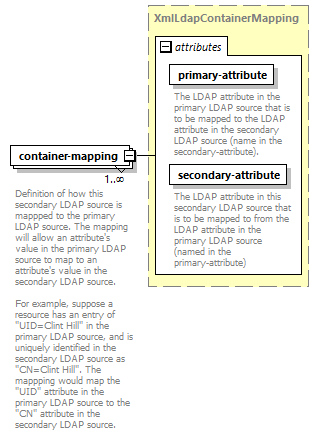| diagram |  |
||||||||||||||||||||||||||||||||||||||||||||||||||||||
| namespace | http://ldap.api.de.n2.tibco.com | ||||||||||||||||||||||||||||||||||||||||||||||||||||||
| type | extension of XmlLdapContainerResource | ||||||||||||||||||||||||||||||||||||||||||||||||||||||
| properties |
|
||||||||||||||||||||||||||||||||||||||||||||||||||||||
| children | container-mapping | ||||||||||||||||||||||||||||||||||||||||||||||||||||||
| attributes |
|
||||||||||||||||||||||||||||||||||||||||||||||||||||||
| annotation |
|
||||||||||||||||||||||||||||||||||||||||||||||||||||||
| source | <xs:complexType name="XmlSecondaryLdapContainerResource"> <xs:annotation> <xs:documentation>Extension of XmlLdapContainerResource, which identifies a secondary LDAP shared resource entry within an LDAP container. An LDAP container can hold a single primary LDAP source and any number of secondary LDAP sources. Secondary LDAP sources hold "foreign-key" references that map their entries to those of the primary LDAP source by named attribute values.</xs:documentation> </xs:annotation> <xs:complexContent> <xs:extension base="XmlLdapContainerResource"> <xs:sequence> <xs:element name="container-mapping" type="XmlLdapContainerMapping" maxOccurs="unbounded"> <xs:annotation> <xs:documentation>Definition of how this secondary LDAP source is mappped to the primary LDAP source. The mapping will allow an attribute's value in the primary LDAP source to map to an attribute's value in the secondary LDAP source. For example, suppose a resource has an entry of "UID=Clint Hill" in the primary LDAP source, and is uniquely identified in the secondary LDAP source as "CN=Clint Hill". The mappping would map the "UID" attribute in the primary LDAP source to the "CN" attribute in the secondary LDAP source.</xs:documentation> </xs:annotation> </xs:element> </xs:sequence> </xs:extension> </xs:complexContent> </xs:complexType> |
element XmlSecondaryLdapContainerResource/container-mapping
| diagram |  |
||||||||||||||||||||||
| type | XmlLdapContainerMapping | ||||||||||||||||||||||
| properties |
|
||||||||||||||||||||||
| attributes |
|
||||||||||||||||||||||
| annotation |
|
||||||||||||||||||||||
| source | <xs:element name="container-mapping" type="XmlLdapContainerMapping" maxOccurs="unbounded"> <xs:annotation> <xs:documentation>Definition of how this secondary LDAP source is mappped to the primary LDAP source. The mapping will allow an attribute's value in the primary LDAP source to map to an attribute's value in the secondary LDAP source. For example, suppose a resource has an entry of "UID=Clint Hill" in the primary LDAP source, and is uniquely identified in the secondary LDAP source as "CN=Clint Hill". The mappping would map the "UID" attribute in the primary LDAP source to the "CN" attribute in the secondary LDAP source.</xs:documentation> </xs:annotation> </xs:element> |
WSDL documentation generated by XMLSpy WSDL Editor http://www.altova.com/xmlspy